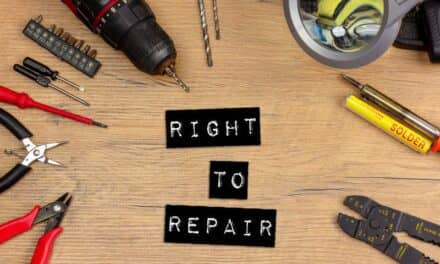To ensure adequate access to the equipment they are charged to maintain, biomeds across the nation are looking for ways to take action
It’s no fun for biomedical engineers when they can’t fix a piece of equipment. And it’s even less so when they know they could do it if they only had the right part or the right instructions, but neither is available.
So, if you want to start a serious discussion with a biomedical engineer or a third-party service provider, start talking about the right-to-repair.
This issue has been simmering for years, says Gay Gordon-Byrne, executive director of the Digital Right to Repair Coalition, which was formed last year to support the rights of digital equipment owners to repair their hardware purchases. But it really took off in the 1990s, she maintains, when original equipment manufacturers began following the lead of Oracle. According to Gordon-Byrne, Oracle aimed to dominate the marketplace for repair by controlling what it referred to as the intellectual property within devices rather than the hardware itself.
“There has been a cascade of vendors that have gone forward since then and made the same claims,” she says. And it’s a strategy that has been pursued across diverse industries, she adds, whether it’s medical devices, automobiles, or ATM machines.
Like many industries, the medical device industry is facing revenue and profitability challenges. According to Dave Harrington, PhD, a healthcare consultant based in Medway, Mass, while the field service area of these companies has traditionally been a cost center geared toward supporting sales, it’s increasingly being viewed as a profit center, and a substantial one at that.
Medical device manufacturers can make a substantial amount of money servicing capital equipment, Harrington says. In order to protect that market, he asserts, they are putting barriers in the way of biomeds or third-party service providers to make it difficult for them to repair equipment.
“I can see [a company] being reluctant to give out a lot of information, but in a large percentage of cases, what we are doing in hospitals isn’t proprietary because much of the equipment we’re talking about is old and has already been replaced by newer models,” he says. “When there’s new technology, there is something proprietary.” But even in that case, he continues, competitors will quickly reverse engineer that technology and put it to their own use. “So how much proprietary information can there actually be?”
Access Curtailed
J. Scot Mackeil, a CBET from Quincy, Mass, who works as a senior biomedical engineer at a major academic medical center in Boston, began his career as a biomed more than 30 years ago when he worked for a laboratory equipment company building wiring and cable assemblies.
“In those days, when you got a technical manual from a company like Beckman Coulter [a company that makes biomedical laboratory instruments], it was so well written that you could literally read it from cover to cover—it was descriptively, completely, and comprehensively written,” Mackeil says. “And then you got into the parts diagrams, and the board layout diagrams and everything in that manual had a part number where you could call the company, open an account, and give them a purchase number for the part you needed to repair. They would ship you the part, and if you got stuck on a repair, you could call up technical support and have an engineer walk you through it, and that would be the end of it.”
That began to change in the late 1980s and early 1990s, Mackeil says, when some of the large manufacturers began pushing back against self-repair by doing things like adding passwords to service software or refusing to sell parts.
One of the most “egregious” ways of curtailing access to critical information needed to repair, Mackeil says, was to create what he calls “fake” service manuals. “They might say service manual on the cover, and have enough technical information to somewhat qualify as a service manual,” he explains. “But as an actual document, it leaves out a lot of the information you need to repair and maintain the device.”
The NFPA 99 Health Care Facilities Code contains requirements relating to the need for manufacturers to provide service manuals and specifies the kinds of information needed in these manuals. Yet, Mackeil says, manufacturers are failing to comply with the spirit of NFPA 99.
He recalls one major supplier that, while aware of the requirements, focused on the term “if applicable” in the language of the requirements to avoid handing out a service manual. “They told us they didn’t want us to repair their equipment, so they weren’t going to give us the information in the service manual,” he says. “And the reason was that they believed that ‘if applicable’ meant that because they didn’t intend for us to service the device ourselves, then we didn’t need any of the information.”
The fact that NFPA 99 urges manufacturers to provide manuals is commendable, says Matthew Baretich of Baretich Engineering, Fort Collins, Colo. The bad news, he says, is that compliance is strictly voluntary.
To date, he explains, “neither CMS nor The Joint Commission have adopted the 2012 edition, although CMS has indicated that it intends to do so and The Joint Commmission has said it will follow suit. If that happens, it will not be until well into 2015. It’s not clear if CMS (or The Joint Commission) will adopt the entire code. CMS sometimes makes changes (as it proposes to do with the 2012 edition of NFPA 101 Life Safety Code).”
Even so, he adds, because NFPA codes and standards are voluntary, “consensus documents have no force unless adopted and enforced by an Authority Having Jurisdiction (AHJ). Even if CMS and TJC adopt NFPA 99 (2012) it’s not likely that they will enforce the provisions relative to device manufacturers.” The bottom line, he concludes, is that CMS and The Joint Commission “have no authority over manufacturers.|
The hurdles to in-house repair, of course, are not limited to service manuals. The life cycle costs of essential medical technologies are bound to be higher, Mackeil adds, when biomeds also can’t access service documents or diagnostic software, or can’t buy reasonably priced repair parts.
Impact on Care
It’s pretty simple, Gordon-Byrne says. “If a device owner has no competitive options, then he’s stuck and is going to have to pay whatever the manufacturer charges for that repair.”
And that “represents one of my key concerns when it comes to right-of-repair in today’s healthcare environment,” Mackeil says. “We have so many healthcare institutions that are living right on the edge financially because of cutbacks in reimbursements, rising labor and health insurance costs, and the rising cost of doing business under the Affordable Care Act. Then you add in the fact there are no checks and balances on medical electronic companies when it comes to the repair of their medical equipment.”
G. Wayne Moore is president and CEO of Acertara Acoustic Laboratories and the medical device industry representative to the Digital Right to Repair coalition. He says that beyond the cost issues associated with right-to-repair, there’s the question of downtime. “How long will the equipment be down?” he asks. “We know that a clinical engineering staff with the right equipment and the right access to information has the ability to [repair these devices] in a safe manner, and that the downtime on the machine will be cut dramatically.”
But, Mackeil says, roadblocks to in-house repair can drastically increase the amount of time a piece of equipment is down. “Let’s say I have an energy device on my workbench and the front panel connector is worn out,” he says. “It’s a vital piece of equipment and has been used so much that when handpieces are plugged into it, we get handpiece identifications errors.”
The repairs, theoretically, should be quite simple, he says. They should involve opening the case, unbolting the handpiece connector from the front panel, unplugging the plugs, and installing a new handpiece connector.
“But [the manufacturer] tells us they’re not going to sell us the part because they only let their own people repair this device, so you’ll have to box it up and send it to us,” Mackeil explains. “So it will take me a lot longer to box it up and generate the return paperwork than it would to have that part sent to me overnight. It could have taken me 30 minutes to install it, and [the device] would have been out of service for less than 72 hours. Instead, it’s in the factory for 2 weeks, and we’ll get a couple of thousand dollars in repair bills.”
What to Do
AAMI is taking steps to bring the healthcare technology management community and manufacturers together to find some common ground on the issue.
“The availability of service manuals has been a major concern of the healthcare technology management (HTM) community for years,” said Steve Campbell, AAMI’s chief operating officer. “But the issue is much bigger than that—it’s about the supportability of technology. That includes the literature provided, the training, and the technical support. AAMI is in a unique position to help on this issue, and that’s why we’ve been tackling it.”
Two years ago, AAMI’s Technology Management Council (TMC) created the Supportability Task Force to help address these issues by providing new resources and encouraging greater communication among stakeholders. For example, the task force recently released a leading practice document called “Flexible Solutions for Device Supportability: A Guide for Manufacturers and HTM Professionals,” that provides guidelines, a sample checklist for medical technology supportability, a comprehensive list of information that should be covered in service manuals, and tips for both manufacturers and healthcare technology management professionals.
“AAMI will continue to facilitate greater understanding by both groups. We’ve started the conversation, which has been needed for a long time. And we’ve made good progress but we still have a long way to go,” said Campbell. “I’m grateful to folks on both sides willing to have a conversation, to find some common ground, to ease up the tension and meet one another half way.”
The Digital Right to Repair Coalition believes the most expeditious way to deal with the issue broadly is legislatively—specifically, a state-by-state legislative approach—according to Gordon-Byrne.
Gordon-Byrne says the coalition is trying to build legislative support in several states and will probably end up trying to get something accomplished in two states in 2015—one “red” state and one “blue” state to make sure that right-to-repair isn’t presented as a partisan issue.
Prospective legislation would deal with several factors that make self-repair possible. “Primarily, it’s access to the documentation, to the firmware patches, and to the diagnostics,” she says. “And, if possible, to parts, although manufacturers don’t want to have to sell parts to competitors, and that’s something we have to respect. But the rest of it is reasonable to expect the owner to want.”
Fortunately, she says, model legislation exists in a law that came out in Massachusetts and that has since formed the basis for a compromise between automobile manufacturers and independent automobile garages and retailers. The automakers have agreed that, starting in 2018, they will make available to independent repair shops just about all of the data provided to their own franchised dealerships.
“We looked at the [Massachusetts bill] and found that the only thing wrong with it is that only mentions cars,” Gordon-Byrne says. “It’s an effective bill.”
Moore believes that at some point, we could see a legal challenge that could clarify things. He points out that some non-medical third-party providers are pretty “large and aggressive” and haven’t been afraid of litigating this area in the past.
“It could either be an OEM suing a third party or a third party taking on an OEM, just like they have in the non-medical space,” Moore speculates. “That could put a lot of focus on the issue and establish a precedent—and I think that could come sooner than later, considering that service revenue right now is a huge component of the bottom-line health of OEMs. Given all the pressure on the sales of new capital equipment to hospitals and the price pressure on the systems that they do sell, the post-sale revenue from services is an important component of their financial health.
“Right now, I don’t know if it makes that big a difference,” he adds. “But if someone started making significant inroads into that revenue stream, then that might be the tipping point for them to get more aggressive from a legal standpoint.”
Healthcare providers “just don’t stand together” when it comes to this issue, Harrington says. He would like to see the “big players in the medical field”—he gives the Department of Veterans Affairs or Kaiser Permanente as examples—take the lead on this issue. He suggests, for instance, refusing to buy from manufacturers if they don’t open right-to-repair access.
Mackeil would like to see some action on a number of different levels. For example, he believes it makes perfect sense for the federal government to involve itself in this issue, considering the urgency of containing healthcare costs. “Consider a healthcare institution that receives public funding,” he points out. “The government wants it to hold down costs and be as cost accountable as possible. And one of the ways in which we can be cost accountable is if we can repair and maintain our own medical devices as economically as possible.”
Jim Carr is director of service and international operations for Advanced Ultrasound Electronics, a Tulsa, Okla-based company that specializes in ultrasound service and repair. He says that one of the real problems with ultrasound is the fact that manufacturers have removed access to diagnostics that helps test the equipment.
He believes that there are people at the FDA who are monitoring the issue. “While they can’t necessarily dictate to the manufacturers that they do this, there have been complaints filed by clinical engineering managers and clinical engineers regarding a lack of diagnostics and a lack of access to the diagnostics that they need, because it causes excess downtime at their hospitals,” Carr says. “I hope that’s getting the attention of the manufacturers and that they look at putting some of these tools back in.”
There there are OEMs that “are excellent partners for biomeds, have great service manuals they share freely, sell parts, and collaborate fully to help reduce repair and maintenance costs,” Mackeil says. “Such companies should serve as models for the industry.
Start with Manuals
Finally, Mackeil says, biomeds really do have the ability to effect change if they are determined to do so—particularly when it comes to the issue of service manuals.
“If you spend any time reading blogs or online journals, you’ll see countless requests for service manuals,” he says. But, a biomed could get his hands on these manuals if he put his foot down at the beginning of the life cycle of that device—when it comes into the hospital for a demo inspection sticker.”
Baretich seconds this strategy. “It doesn’t work perfectly because some manufacturers won’t budge and facilities may have to give in,” he says. “But it works reasonably well.”
When a salesman comes in asking for the sticker, Mackeil says, what he’s really doing is looking for an opportunity to get that device into the hands of the clinicians so he can make a sale.
It’s at that point in the process, he asserts, that a biomed should make it clear that before that device gets into the hospital, it will have to undergo a complete and comprehensive performance and electrical safety test. “And before I do anything with that device, I’m going to have to [receive] a full factory service manual so I can read it and see what the device [entails],” Mackeil continues. “And then I’ll use my testing and measuring equipment to verify that this device—which has been probably been bouncing around in the trunk of a car—is functioning correctly and that what it’s doing is per the specifications listed in the factory service manual.”
The chances are, Mackeil says, that the salesman is going to look at him like he “has two heads” and argue that the manual is confidential and proprietary. “But my answer to that will be, ‘If I can’t see the manual, you don’t get the sale.’?”
The vast majority of the time, he’ll get the manual, he says. “One of the reasons we have a problem with service information for medical equipment is that far too many biomeds basically give vendors a pass. We could solve this whole problem of service manuals if any time a biomed was presented with a device to check into the hospital, he said, ‘I’m sorry, I can’t check the device in until I see the full factory service manual.’ ”
Baretich adds that in his experience, the problem is usally that healthcare facilities don’t try to require manuals. In such cases, he says “best practice for us in the HTM profession is to work with administration, purchasing, safety committees, or whoever, to make manuals a standard condition of purchase (and to refuse to pay the purchase invoice until the manuals are received).”
For Mackeil, success at obtaining manuals is practically a job requirement. “For every biomed that doesn’t have a service manual that they need,” he says, “another biomed has failed in his job at a critical juncture in the life cycle of that device.”
Michael Bassett is a contributing writer for 24×7. For more information, contact editorial director John Bethune at [email protected].











Fellow Biomeds, Biomed and CE is a support service that needs to provide value and service to patients, caregivers and the healthcare system. One of the key things we do is fix things for less money. If we can’t demonstrate to the C-suite this CORE function, what other cards do we have left in our hand?
Every dollar we don’t send out the door for repair and maintenance is one more dollar we can use to serve our patient population. Every dollar we save in back-end costs results in ($3-4) less cost to payers and in turn, lower insurance costs for working families. IMHO, the parasitic costs of technology ownership are huge profit centers for OEMs that they have unilaterally declared “immune” from the belt tightening the rest of the healthcare industry has been subjected to. They do this by hijacking our “right to repair” our equipment and making hospitals pay for repairs and parts at whatever costs they want to charge. Healthcare providers are accountable for costs to CMMS, insurance payers, working families and patients who have to pay the bills. IMHO, Right to Repair is something every responsible hardworking Biomed should drive forward. Yes we can make a difference and that difference starts at your work bench.
Great article! It pretty much captures all the issues many of us in the repair side of this industry experience. I have heard every excuse the OEM’s have for not allowing others to work on the equipment and as the article points out a quick repair costs us thousands. I have seen nothing more than plastic posts on a device broken and the OEM would not replace unless we purchased the whole device for $12K. Fortunately we were able to have the part fabricated off our drawings and saved over $11.8K in the process.
There are many similar stories out there and it amazes me that even with the OEM’s reluctance to assist the biomed community, the job of repairing/maintaining the equipment is still being professionally accomplished.
Good luck to AAMI, there needs to be some enforceable legal measures in place that allow the owners/3rd party ISO to help reduce the cost of healthcare and OEM documentation is right at the top of that list.
Great article; only thing I can add that access to service manuals will save cost given that many manufacturers are charging for phone or online support and the difficulty repairing equipment manufactured out of the U.S. And we have to get clinical and purchasing staff on board with not clearing a new device for use when a service manual is not made available given the pressure a favorite sale person can exert via none bmet personnel.
Given the CMS requirements for following manufacturer PM procedures on medical imaging equipment I see a conflict with the ability to accomplish this. With some of the equipment I service it is impossible or near impossible to access certain areas of the service software to perform required tests. In this case, I am not able to follow the manufacturers procedure and am thus in violation of the CMS rule.
I repair lab equipment and ultralow freezers for a living. What i can tell you is these companys are not facing any profit challanges… and you should thank them for protecting your expensive but important equipment from these engineers at these facilitys. I have fixed countless ultralowes condemed by a engineer who doesnt have any idea what hes even looking at with a $100 relay. Ive seen a dozen or so autoclaves worth $10,000+ chopped to bits with a sawzall because a engineer got there hands on a manual online and still failed to fix it… one most recent was a 15,000 autoclave that was about to be dismantled and disposed. All because there team of engineers couldnt figure out that the air supplying the pnumatics was off… if you want your right to repair thats great… more money for me when i have to fix a house engineers trainwreck… if you want to fix equipment and your able to.. get a job with a company that does that.. if you want to sit on your ass and fix a door handle once in a while. Be a house engineer. That simple.
It appears that these companies have more confidence in third party repairs, than what your post is implying.